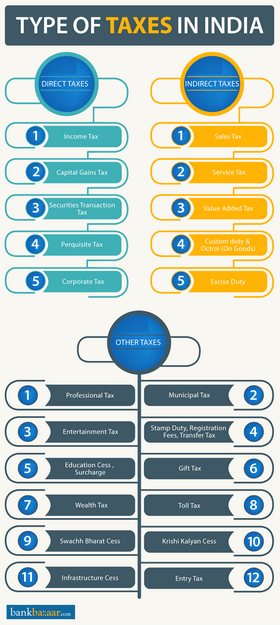Soliqlarning turlari
Soliqlar ikki xil bo'ladi, to'g'ridan-to'g'ri va egri soliqlar. Farqi ushbu soliqlarni amalga oshirish usulida paydo bo'ladi. Ba'zilari qo'rqinchli daromad solig'i, boylik solig'i, korporativ solig'i va boshqalar kabi to'g'ridan-to'g'ri siz tomoningizdan to'lanadi, boshqalari esa bilvosita soliqlar, masalan, qo'shilgan qiymat solig'i, xizmat solig'i, savdo solig'i va hokazo.
1. To'g'ridan-to'g'ri soliqlar
2. Bilvosita soliqlar
Ammo, bu ikki an'anaviy soliqlardan tashqari, ma'lum bir kun tartibiga xizmat qilish uchun markaziy hukumat tomonidan kuchga kirgan boshqa soliqlar ham mavjud. "Boshqa soliqlar" to'g'ridan-to'g'ri va bilvosita soliqlardan undiriladi, masalan, yaqinda kiritilgan Swachh Bharat solig'i, Krishi Kalyan solig'i va infratuzilma solig'i.
1. To'g'ridan-to'g'ri soliq
To'g'ridan-to'g'ri soliq, yuqorida aytib o'tilganidek, to'g'ridan-to'g'ri siz to'laydigan soliqlardir. Ushbu soliqlar to'g'ridan-to'g'ri yuridik yoki jismoniy shaxsdan undiriladi va boshqa hech kimga o'tkazilmaydi. Ushbu to'g'ridan-to'g'ri soliqlarni e'tiborsiz qoldiradigan organlardan biri To'g'ridan-to'g'ri soliqlar markaziy kengashi (CBDT)bo'lib, daromadlar departamentining bir qismidir. U o'z vazifalarini bajarishda yordam berish uchun to'g'ridan-to'g'ri soliqlarning turli jihatlarini tartibga soluvchi turli xil aktlarni qo'llab-quvvatlaydi.
Ushbu harakatlarning ba'zilari:
· Daromad solig'i to'g'risidagi qonun:
Bu 1961 yildagi IT qonuni sifatida ham tanilgan va Hindistonda daromad solig'ini boshqaradigan qoidalarni belgilaydi. Ushbu qonun soliqqa tortiladigan daromad har qanday manbadan olinishi mumkin, masalan, biznes, uy yoki mulkka egalik qilish, investitsiyalar va maoshlardan olingan daromadlar va boshqalar. Bu muddatli omonat yoki hayot sug'urtasi bo'yicha soliq imtiyozlari qancha bo'lishini belgilaydigan aktdir. Bu, shuningdek, investitsiyalar orqali sizning daromadingizning qancha qismini tejashingiz mumkinligini va daromad solig'i uchun slab qanday bo'lishini hal qiluvchi aktdir.
· Boylik solig'i to'g'risidagi qonun:
Boylik solig'i to'g'risidagi qonun 1951 yilda qabul qilingan va jismoniy shaxs, kompaniya yoki hindu yagona oilasining sof boyligi bilan bog'liq soliqqa tortish uchun javobgardir. Boylik solig'ining eng oddiy hisob-kitobi, agar sof boylik Rs dan oshsa. 30 lakhs, keyin Rs dan oshgan summaning 1%. 30 million soliq to'lanishi kerak edi. 2015 yilda e'lon qilingan byudjetda u bekor qilingan. O'shandan beri u rupiyadan ortiq daromad oladigan shaxslar uchun 12% qo'shimcha to'lov bilan almashtirildi. Yiliga 1 mln. Rs dan ortiq daromadga ega bo'lgan kompaniyalar uchun ham amal qiladi. Yiliga 10 mln. Yangi yo'riqnomalar boylik solig'i orqali undiriladigan summadan farqli o'laroq, hukumat soliqlar miqdorini keskin oshirdi.
· Gift soliq qonuni:
Sovg'a solig'i to'g'risidagi qonun 1958 yilda kuchga kirdi va agar shaxs sovg'a, pul yoki qimmatbaho narsalarni sovg'a sifatida olgan bo'lsa, bunday sovg'alar uchun soliq to'lanishi kerakligini aytdi. Bunday sovg'alarga soliq 30% darajasida saqlanib qoldi, ammo 1998 yilda u bekor qilindi. Dastlab, agar sovg'a berilgan bo'lsa va u mulk, zargarlik buyumlari, aktsiyalar va boshqalar kabi bo'lsa, soliqqa tortilishi mumkin edi. Yangi qoidalarga ko'ra, aka-uka, opa-singil, ota-ona, turmush o'rtog'i, xola va amakilar kabi oila a'zolari tomonidan beriladigan sovg'alar soliqqa tortilmaydi. Hatto mahalliy hokimiyat tomonidan sizga berilgan sovg'alar ham ushbu soliqdan ozod qilingan. Endi soliq qanday ishlaydi, agar kimdir ozod qilingan tashkilotlardan tashqari, sizga Rs qiymatidan oshgan narsani sovg'a qilsa. 50 000, keyin butun sovg'a miqdori soliqqa tortiladi.
· Xarajatlar uchun soliq qonuni:
Bu 1987-yilda vujudga kelgan va mehmonxona yoki restoran xizmatlaridan foydalanishda shaxs sifatida koʻtarilishi mumkin boʻlgan xarajatlar bilan bogʻliq boʻlgan hujjatdir. Bu Jammu va Kashmirdan tashqari butun Hindiston uchun amal qiladi. Unda aytilishicha, ba'zi xarajatlar Rs dan oshsa, ushbu qonunga muvofiq undiriladi. Mehmonxona uchun 3000 va restoranda qilingan barcha xarajatlar.
· Foiz solig'i to'g'risidagi qonun:
1974 yilgi Foiz solig'i to'g'risidagi qonun muayyan muayyan vaziyatlarda olingan foizlar bo'yicha to'lanishi kerak bo'lgan soliq bilan bog'liq. Qonunga kiritilgan so'nggi o'zgartirishda ushbu akt 2000 yil mart oyidan keyin olingan foizlarga taalluqli emasligi ta'kidlangan.
Quyida to'g'ridan-to'g'ri soliqlarning barcha turlariga misollar keltirilgan:

To'g'ridan-to'g'ri soliqlarga misollar
Bular siz to'laydigan to'g'ridan-to'g'ri soliqlarning ba'zilari
a) daromad solig'i:
Bu eng mashhur va eng kam tushunilgan soliqlardan biridir. Bu sizning moliyaviy yilingizda daromadingizdan undiriladigan soliqdir. Daromad solig'ining ko'plab jihatlari mavjud, masalan, soliq stavkalari, soliqqa tortiladigan daromad, manbadan ushlab qolingan soliq (TDS), soliqqa tortiladigan daromadni kamaytirish va boshqalar. Soliq jismoniy shaxslarga ham, kompaniyalarga ham tegishli. Jismoniy shaxslar uchun ular to'lashlari kerak bo'lgan soliq ular qaysi soliq toifasiga kirayotganiga bog'liq. Ushbu qavs yoki plitalar baholovchining yillik daromadiga qarab to'lanishi kerak bo'lgan soliqni belgilaydi va yuqori daromad guruhlari uchun soliqsiz dan 30% soliqgacha o'zgaradi.
Hukumat jismoniy shaxslarning turli guruhlari, ya'ni umumiy soliq to'lovchilar, keksa fuqarolar (60 yoshdan 80 yoshgacha bo'lgan odamlar va juda keksa fuqarolar (80 yoshdan oshganlar)) uchun turli soliq stavkalarini belgilab qo'ydi.
b) Sarmoyadan olinadigan daromad solig'i:
Bu katta miqdordagi pul olganingizda to'lanadigan soliq. Bu investitsiyadan yoki mulkni sotishdan bo'lishi mumkin. U odatda ikki xil bo'ladi: 36 oydan kamroq muddatga investitsiyalar bo'yicha qisqa muddatli kapital daromadlari va 36 oydan ortiq vaqt davomida ushlab turilgan investitsiyalar bo'yicha uzoq muddatli kapital daromadlari. Ularning har biri uchun qo'llaniladigan soliq ham juda farq qiladi, chunki qisqa muddatli daromad solig'i siz kiradigan daromadlar qatoriga qarab hisoblanadi va uzoq muddatli daromadlarga soliq 20% ni tashkil qiladi. Ushbu soliqning qiziq tomoni shundaki, daromad har doim ham pul shaklida bo'lishi shart emas. Bu, shuningdek, naturadagi ayirboshlash bo'lishi mumkin, bunda ayirboshlash qiymati soliqqa tortish uchun hisobga olinadi.
c) Qimmatli qog'ozlar bo'yicha operatsiyalar uchun soliq:
Hech kimga sir emaski, agar siz fond bozorida qanday qilib to'g'ri savdo qilishni va qimmatli qog'ozlar bilan savdo qilishni bilsangiz, katta miqdorda pul ishlashingiz mumkin. Bu ham daromad manbai, lekin uning qimmatli qog'ozlar bilan operatsiyalar solig'i deb nomlanuvchi o'z solig'i bor . Ushbu soliqni qanday undirish soliqni ulush narxiga qo'shish orqali amalga oshiriladi. Bu shuni anglatadiki, siz har safar aktsiyalarni sotib olganingizda yoki sotganingizda ushbu soliqni to'laysiz. Hindiston fond birjasida sotiladigan barcha qimmatli qog'ozlarga ushbu soliq biriktirilgan.
d) Majburiy soliq:
Perkvizitlar - bu ish beruvchilar xodimlarga berishi mumkin bo'lgan barcha imtiyozlar yoki imtiyozlar. Ushbu imtiyozlarga kompaniya tomonidan taqdim etilgan uy yoki kompaniya tomonidan sizga foydalanish uchun berilgan avtomobil kirishi mumkin. Ushbu imtiyozlar nafaqat avtomobillar va uylar kabi katta kompensatsiyalar bilan cheklanib qolmaydi, balki ular hatto yoqilg'i yoki telefon uchun to'lovlar kabi narsalarni ham o'z ichiga olishi mumkin. Bu soliq qanday undiriladi, bu imtiyoz kompaniya tomonidan qanday olinganligi yoki xodim tomonidan qanday foydalanilganligini aniqlash orqali amalga oshiriladi. Avtomobillarga kelsak, kompaniya tomonidan taqdim etilgan va shaxsiy va rasmiy maqsadlarda foydalaniladigan avtomobil soliqqa tortilishi mumkin, faqat rasmiy maqsadlarda foydalaniladigan avtomobil soliqqa tortilmaydi.
e) Korporativ soliq:
Korxona solig'i - bu kompaniyalar tomonidan olingan daromadlardan to'lanadigan daromad solig'i. Ushbu soliq, shuningdek, kompaniya qancha soliq to'lashi kerakligini hal qiladigan o'ziga xos plita bilan birga keladi. Masalan, daromadi Rs dan kam bo'lgan mahalliy kompaniya. Yiliga 1 crore, bu soliqni to'lashi shart emas, lekin Rs dan ortiq daromadga ega bo'lgan soliq. Yiliga 1 million bu soliqni to'lashi kerak bo'ladi. U qo'shimcha to'lov deb ham ataladi va turli daromadlar uchun farqlanadi. Bundan tashqari, korporativ soliq 41.2%,10 bo'lishi mumkin bo'lgan xalqaro kompaniyalar uchun ham farq qiladi, agar kompaniyaning daromadi Rs dan kam bo'lsa. <n5> million va boshqalar.
Korporativ soliqning to'rt xil turi mavjud. Ular:
· Minimal muqobil soliq:
Minimal muqobil soliq yoki MAT, asosan, daromad solig'i departamenti kompaniyalarni eng kam soliq to'lashga majburlash usulidir, bu hozirda 18,5% ni tashkil qiladi. Ushbu soliq shakli Daromad solig'i to'g'risidagi qonunning 115JA bo'limini kiritish orqali kuchga kirdi. Biroq, infratuzilma va energetika sohalarida ishlaydigan kompaniyalar MAT to'lashdan ozod qilingan.
Kompaniya MATni to'lagandan so'ng, u to'lovni oldinga o'tkazishi va ma'lum shartlarga rioya qilgan holda keyingi besh yil davomida to'lanishi kerak bo'lgan oddiy soliqqa hisob-kitob qilishi (tuzatilishi) mumkin.
· Qo'shimcha foyda solig'i:
Fringe Benefit Tax yoki FBT, ish beruvchining o'z xodimlariga taqdim etgan deyarli barcha qo'shimcha imtiyozlarga nisbatan qo'llaniladigan soliq bo'lgan. Ushbu soliqda bir qancha jihatlar yoritilgan. Ulardan ba'zilari o'z ichiga oladi:
i) Ish beruvchining sayohat (LTA), xodimlarning farovonligi, turar joy va o'yin-kulgi uchun xarajatlari.
ii) Ish beruvchi tomonidan taqdim etilgan har qanday muntazam qatnov yoki qatnov bilan bog'liq xarajatlar.
iii) Ish beruvchining sertifikatlangan pensiya jamg'armasiga qo'shgan hissasi.
iv) Ish beruvchining aktsiya opsion rejalari (ESOPs).
FBT Hindiston hukumati boshqaruvi ostida 2005 yil 1 apreldan boshlab boshlangan. Biroq, keyinchalik soliq 2009 yilda o'sha paytdagi moliya vaziri Pranab Mukerji tomonidan 2009 yilgi ittifoq byudjeti sessiyasida bekor qilingan edi.
· Dividendlarni taqsimlash uchun soliq:
Dividendlarni taqsimlash solig'i 2007 yilgi Ittifoq byudjeti tugagandan so'ng joriy etildi. Bu, asosan, kompaniyalardan o'z investorlariga to'laydigan dividendlar asosida undiriladigan soliqdir. Ushbu soliq investor o'z investitsiyalaridan oladigan yalpi yoki sof daromadga nisbatan qo'llaniladi. Hozirgi vaqtda DDT darajasi 15% ni tashkil qiladi.
· Bank naqd operatsiyalari uchun soliq:
Bank naqd operatsiyalari solig'i Hindiston hukumati tomonidan bekor qilingan soliqning yana bir shaklidir. Soliqqa tortishning ushbu shakli 2005-2009 yillarda amalda bo'lgan, o'sha paytdagi tashqi ishlar vaziri Pranab Mukerji soliqni bekor qilgunga qadar. Ushbu soliq har bir bank operatsiyasi (debet yoki kredit) uchun 0.1%,<n2> stavkada soliqqa tortilishini taklif qildi.
2. Bilvosita soliq:
Ta'rifga ko'ra, bilvosita soliqlar tovarlar yoki xizmatlardan olinadigan soliqlardir. Ular to'g'ridan-to'g'ri soliqlardan farq qiladi, chunki ularni to'g'ridan-to'g'ri davlatga to'laydigan shaxsdan undirilmaydi, aksincha ular mahsulotdan undiriladi va vositachi, mahsulotni sotuvchi shaxs tomonidan undiriladi. Bilvosita soliqning eng keng tarqalgan misollari Bilvosita soliqQQS (Qo'shilgan qiymat solig'i), import qilinadigan tovarlarga soliqlar, savdo solig'i va boshqalarbo'lishi mumkin. Ushbu soliqlar ularni xizmat yoki mahsulot narxiga qo'shish orqali undiriladi, bu esa mahsulot tannarxini oshirishga olib keladi.
Bilvosita soliqlarga misollar:
Bu siz to'laydigan umumiy bilvosita soliqlardan ba'zilari.
a) Sotuv solig'i:
Nomidan ko'rinib turibdiki, savdo solig'i mahsulotni sotishdan olinadigan soliqdir. Ushbu mahsulot Hindistonda ishlab chiqarilgan yoki import qilingan narsa bo'lishi mumkin va hatto ko'rsatilgan xizmatlarni qoplashi mumkin. Ushbu soliq mahsulot sotuvchisidan undiriladi, u keyinchalik uni ushbu mahsulotni sotib olgan shaxsga mahsulot narxiga qo'shilgan savdo solig'i bilan o'tkazadi. Ushbu soliqning cheklovi shundaki, u ma'lum bir mahsulot uchun faqat bittasini undirish mumkin, ya'ni agar mahsulot ikkinchi marta sotilsa, unga savdo solig'i qo'llanilmaydi.
Asosan, mamlakatdagi barcha shtatlar o'zlarining savdo solig'i to'g'risidagi qonuniga amal qiladilar va o'zlariga mahalliy aholining foizini to'laydilar. Bundan tashqari, ba'zi shtatlar aylanma solig'i, sotib olish solig'i, ish operatsiyalari solig'i va shunga o'xshash boshqa qo'shimcha to'lovlarni ham undiradilar. Bu, shuningdek, savdo solig'i turli shtat hukumatlari uchun eng katta daromad ishlab chiqaruvchilardan biri bo'lishining sababidir. Shuningdek, ushbu soliq markaziy va shtat qonunchiligiga muvofiq olinadi.
b) Xizmat solig'i:
Hindistonda sotilgan tovarlar narxiga savdo solig'i qo'shilganidek, Hindistonda ko'rsatiladigan xizmatlarga ham xizmat solig'i qo'shiladi. 2015 yilgi byudjetni o'qishda xizmat ko'rsatish solig'i 12.36%,14% foizdan <n4> foizga ko'tarilishi e'lon qilindi. Bu tovarlarga emas, balki xizmatlar ko'rsatuvchi kompaniyalarga nisbatan qo'llaniladi va har oyda yoki har chorakda bir marta xizmatlar ko'rsatilishiga qarab yig'iladi. Agar muassasa yakka tartibdagi xizmat ko'rsatuvchi provayder bo'lsa, xizmat solig'i faqat mijoz to'lovlarni to'laganidan keyin to'lanadi, biroq kompaniyalar uchun xizmatlar solig'i mijozning hisob-kitobni to'lashidan qat'i nazar, schyot-faktura ko'tarilgan paytdan boshlab to'lanadi.
Esda tutish kerak bo'lgan muhim narsa shundaki, restorandagi xizmat ovqat, ofitsiant va binolarning o'zidan iborat bo'lganligi sababli, xizmat ko'rsatish solig'iga nima mos kelishini aniqlash qiyin. Har qanday noaniqlikni bartaraf etish uchun bu borada restoranlarda xizmat ko‘rsatish solig‘i umumiy hisobning atigi 40% foizidan undirilishi e’lon qilindi.
- GST - Tovarlar va xizmatlar solig'i:
Tovarlar va xizmatlar solig'i (GST) Hindistonning bilvosita soliq tizimidagi eng yirik islohotdir, chunki bozor taxminan 25 yil oldin ochilgan. GST iste'molga asoslangan soliqdir, chunki u iste'mol sodir bo'ladigan joyda qo'llaniladi. GST qo'shilgan qiymatga ega bo'lgan tovarlar va xizmatlar uchun etkazib berish zanjirida iste'molning har bir bosqichida undiriladi. Tovarlar va xizmatlarni xarid qilish uchun to'lanishi kerak bo'lgan GST to'lovlar va xizmatlarni etkazib berish uchun to'lanishi kerak bo'lgan GSTga hisoblab chiqilishi mumkin, savdogar amaldagi GST stavkasini to'laydi, lekin soliq krediti mexanizmi orqali uni qaytarib talab qilishi mumkin.
c) Qo'shilgan qiymat solig'i:
Tijorat solig'i sifatida ham tanilgan QQS nol reytingli tovarlarga nisbatan qo'llanilmaydi (masalan. oziq-ovqat va asosiy dori-darmonlar) yoki eksportga kiradiganlar. Ushbu soliq to'g'ridan-to'g'ri ishlab chiqaruvchilar, dilerlar va distribyutorlardan oxirgi foydalanuvchigacha bo'lgan etkazib berish zanjirining barcha bosqichlarida olinadi.
Qo'shilgan qiymat solig'i shtat hukumati ixtiyoriga ko'ra undiriladigan soliq bo'lib, u birinchi marta e'lon qilinganida hamma shtatlarda ham qo'llanilmagan. Soliq shtatda sotiladigan turli tovarlardan undiriladi va soliq miqdori davlat tomonidan belgilanadi. Masalan, Gujratda hukumat barcha yaxshi narsalarni jadval deb ataladigan turli toifalarga ajratdi. 3 ta jadval mavjud va har bir jadvalning QQS foizi mavjud. 3-jadval uchun QQS 1%, 2-jadval uchun QQS 5% va hokazo. Hech qanday toifaga kiritilmagan tovarlar uchun QQS 15% ni tashkil qiladi.
d) Bojxona to'lovi va Octroi:
Boshqa davlatdan olib kirish kerak bo'lgan har qanday narsani sotib olganingizda, undan to'lov olinadi va bu bojxona to'lovidir. Bu quruqlik, dengiz yoki havo orqali keladigan barcha mahsulotlarga tegishli. Agar siz Hindistonga boshqa mamlakatda sotib olingan mahsulotlarni olib kirsangiz ham, undan bojxona to'lovi undirilishi mumkin. Bojxona to'lovining maqsadi mamlakatga kiruvchi barcha tovarlarga soliq solinishi va to'lanishini ta'minlashdan iborat. Bojxona to'lovi boshqa mamlakatlar uchun tovarlar soliqqa tortilishini ta'minlaganidek, oktroi Hindistonda davlat chegaralarini kesib o'tadigan tovarlar tegishli ravishda soliqqa tortilishini ta'minlash uchun mo'ljallangan. U shtat hukumati tomonidan undiriladi va xuddi bojxona to'lovi kabi ishlaydi.
e) Aktsiz solig'i:
Bu Hindistonda ishlab chiqarilgan yoki ishlab chiqarilgan barcha tovarlardan olinadigan soliq. Bu bojxona to'lovidan farq qiladi, chunki u faqat Hindistonda ishlab chiqarilgan narsalarga nisbatan qo'llaniladi va Markaziy qo'shilgan qiymat solig'i yoki CENVAT sifatida ham tanilgan. Bu soliq davlat tomonidan tovar ishlab chiqaruvchidan undiriladi. U, shuningdek, ishlab chiqarilgan tovarlarni qabul qiluvchi va tovarlarni ishlab chiqaruvchidan o'zlariga tashish uchun odamlarni ish bilan ta'minlaydigan korxonalardan undirilishi mumkin.
Markaziy hukumat tomonidan o'rnatilgan Markaziy aksiz qoidasi har qanday "aksiz to'lanadigan tovarlar"ni ishlab chiqaruvchi yoki ishlab chiqaruvchi yoki bunday tovarlarni omborda saqlaydigan har bir shaxs ushbu tovarlarga nisbatan qo'llaniladigan bojni to'lashi kerakligini ko'rsatadi. Ushbu qoidaga ko'ra, har qanday boj to'lanishi kerak bo'lgan aktsiz to'lanadigan tovarlarni ular ishlab chiqarilgan yoki ishlab chiqarilgan joydan boj to'lamasdan olib o'tishga yo'l qo'yilmaydi.













